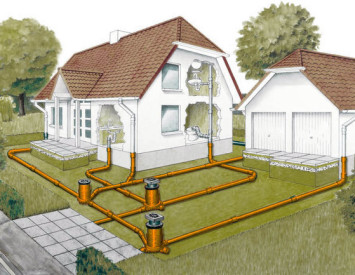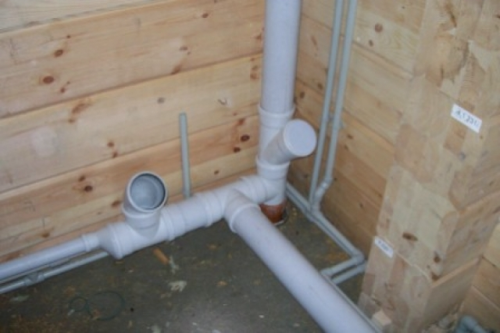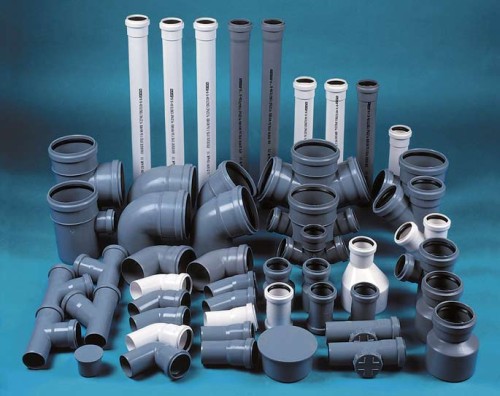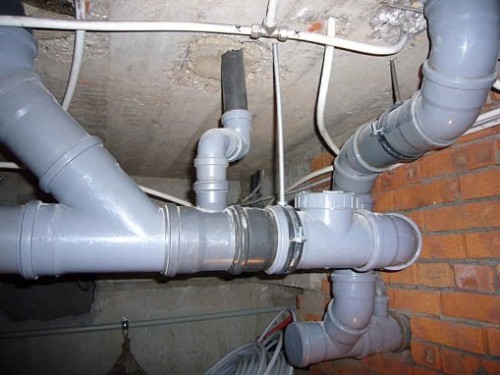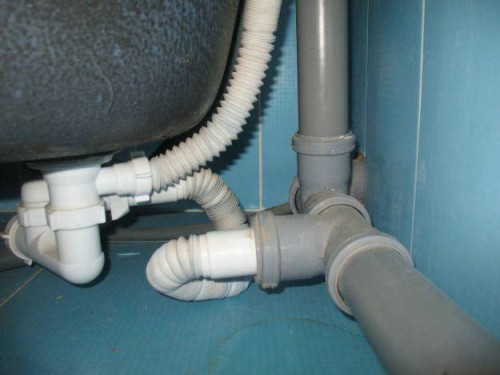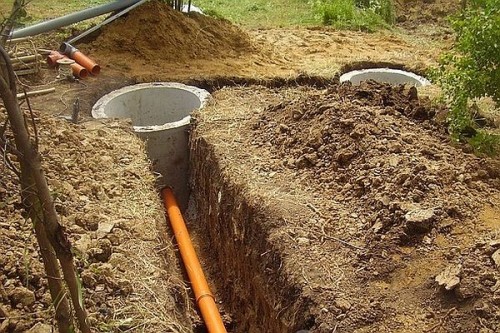It is not difficult to conduct a sewer in a private house. Heavy physical labor is necessary only when digging a divert trench. Modern plastic pipes are easily mounted and assembled subject to the correctly compiled project. The sewage project in a private house is agreed in Vodokanal.
Content
Based on the project, the necessary meter of pipes, fittings and components for the arrangement of sewage in a private house, photos of some necessary parts are located below. Check out the process of installing sewage in a private house, the video at the end of the article will help you.
Types of pipes for sewage in a private house
It is not difficult to choose pipes for the installation of sewage system in a private house. In the retail network, there are a lot of pipes and components to them to choose from.
- Cast iron sewer pipes are traditional in plumbing and tested by time. It is quite difficult to mount them, they have considerable weight and cost, but the sewer system from cast -iron pipes is installed for a long time. Supply or alterations without dismantling is quite problematic. Over time, caverns and sinks form on the inner surface, on which growths contribute to blockages are formed.
- There are several types of plastic pipes. Polyvinyl chloride (PVC), strong and inexpensive. Gray pipes are produced for internal wiring and orange for the outer. Polypropylene (PP) pipes - heat -resistant flexible corrugated. Polyethylene (PVP) - have high strength and flexibility. Fiberglass pipes - reinforced with fiberglass.
- All sewer plastic pipes have low weight and low cost, and the presence of a large selection of components and accessories allows a sewer of any complexity. The warranty life of plastic pipes is at least 50 years. High cross -country ability and lack of blockages with proper operation justify the popularity of plastic sewage.
- Ceramic sewer pipes are less common, but they also have several advantages. They are made of clay with the addition of kaolin or chamotte and baked at high temperature. A polyester resin is applied to the bells to seal the connection. The internal smooth surface of ceramic pipes provides high cross -country ability. Fragility and high weight are the disadvantages of such pipes.
Concrete and asbestos cement are now practically not used in sewer systems. Poor operational qualities and the absence of components are not in their favor. Therefore, making a sewer in a private house will be reasonable from modern materials.
Wiring and installation of internal sewage in a private house
Sketch the drawing - an internal wiring diagram for the installation of sewage in a private house. Designate the premises and plumbing objects planned for connection on it. The slope of the pipes reduced to the central node is 1 cm per linear meter.
- Installation of plastic sewage of a private house with your own hands does not require special skill. The pipes are cut in size and inserted into the bell. Experienced plumbing in the process of docking process the edge of the plastic pipe with sandpaper with a small fraction and lubricated with a thin layer of solidol.
- For a bathroom and a ceramic linen shell, pipes with a diameter of 50 mm are used. For kitchen sinks 40 - 50 mm. The toilet is connected to a pipe with a diameter of 100 mm. Proper wiring is laid from the kitchen sink through the bathroom to the toilet. At the place of installation of the toilet, a mounting tee is installed, in which the drain pipes are launched. From the toilet, the track is displayed on the street.
- Autonomous sewage in a private house is equipped during construction. The internal wiring is shed under the floor or passes under the wall. When replacing sewers, they use old tracks. In case of blockage, depending on the layout, sewer wiring is equipped with 1 - 2 audit tees. In this case, you do not need to disassemble the entire system for cleaning. It is enough to unscrew the lid and the system will be available for a plumbing cable.
- The sewer pipes of internal wiring passing through the wall are fixed with plastic clamps. Holes for dowels are drilled in the wall, pipes are started and fixed with special clamps. The distance between the clamps is 1.5 - 2 meters.
Connecting plumbing devices to the sewer system
To connect plumbing components and devices, tees with releases of the desired diameter are inserted into a sunbed or riser and are joined with cast hoses of siphones.
- Siphons are installed on the bath, kitchen sink and sink. Siphons are made of plastic or metal with a rigid or flexible drain hose, which is inserted into the bell of the tee of the sewer system. Sealing rubber rings give good sealing, and for reliability, the joints are coated with waterproof silicone.
- The corrugated flexible issue is more convenient for installation. It is produced in different diameters and purpose. For kitchen sinks and washing machines 40 - 50 mm in diameter, for baths and ceramic shells - 50 mm, for toilets and bidet - 100 mm. There are special drainage systems for showers and trapics.
Laying the sewer track from a private house to the well
The release of the sewer pipe from the internal wiring in the house is located in the foundation at a depth of 75 cm. If technically there is no ability to place the release at the required depth, the sewer pipes are insulated.
- Mineral wool, polystyrene foam or other materials suitable for this are used to warm pipes. In the case of a blockage in winter, without insulation, the track is possible. Defrosting it is quite problematic. It is necessary to open the pipes and gently defrost with hot water or air. Plastic pipes cannot be defrosted with open fire, and they are jawning from high temperatures.
- From the release in the foundation to the drain well, the trench is born. The calculated slope is approximately 30 °. Avoid turns and vertical differences. On the highway every 10 meters are equipped with viewing wells. The correct level of the trench is checked by the twine stretched along the bottom.
- In the laying of the intermediate wells and the end point, which is the drain pit or a well of the central sewer, metal sleeves are laid. The sleeves exceed the plastic sewer pipe in the diameter by 2 - 3 cm and protect it from deformation in case of precipitation of the well.
In those situations where there is no central sewage nearby, the drain pit is equipped with a septic tank. This is a local treatment building used in dachas or suburban areas.
